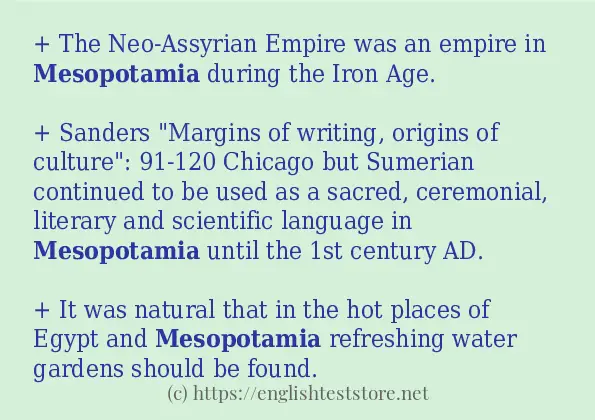How to use in-sentence of “mesopotamia”:
+ The Neo-Assyrian Empire was an empire in Mesopotamia during the Iron Age.
+ Sanders “Margins of writing, origins of culture”: 91-120 Chicago but Sumerian continued to be used as a sacred, ceremonial, literary and scientific language in Mesopotamia until the 1st century AD.
+ It was natural that in the hot places of Egypt and Mesopotamia refreshing water gardens should be found.
+ True potter’s wheels, which are freely-spinning and have a wheel-and-axle mechanism, were developed in Mesopotamia by 4200–4000BC.
+ In ancient Mesopotamia seals were engraved on cylinders, which could be rolled to create an impression on clay.
+ Babylonia was a city state in Mesopotamia in the 2nd millennium BC, over 3000 years ago.

Example sentences of “mesopotamia”:
+ The origins of the division of the Saint Thomas Christians into Northist and Southist groups is traced back to the arrival of the SyriaSyrian merchant Thomas of Cana from Mesopotamia to India in the 4th or 8th century.
+ Mitanni was a Hurrian kingdom in northern Mesopotamia from ca.
+ Southern Mesopotamia is made up of marshy areas and wide, flat, plains.
+ The origins of the division of the Saint Thomas Christians into Northist and Southist groups is traced back to the arrival of the SyriaSyrian merchant Thomas of Cana from Mesopotamia to India in the 4th or 8th century.
+ Mitanni was a Hurrian kingdom in northern Mesopotamia from ca.
+ Southern Mesopotamia is made up of marshy areas and wide, flat, plains.
+ The events that followed the Rowlatt Act in 1919 were also influenced by the events linked to the Ghadar conspiracy, At the time, British Indian Army troops were returning from the battlefields of Europe and Mesopotamia to an economic depression in India.
+ In Mesopotamia the Sumerians wrote on clay tablets, many of which have survived today.
+ Some ancient clay tablets found in Mesopotamia contain tables with rounded values of reciprocals and square roots in base 60.
+ Thomas Christians and minority Knanaya traces the divide to the figure of Thomas of Cana, a Syrian merchant who led a group of 72 Jewish ChristiansJewish-Christian immigrant families, a bishop named Uraha Mar Yausef, and clergymen from Mesopotamia to settle in Cranganore, India in the 4th century.
+ It was found near the ruins of Babylon, Mesopotamia in 1879.
+ The Fertile Crescent is a historical region in the Middle East that includes the The LevantLevant, Mesopotamia and Ancient Egypt.
+ Hammurabi’s allies in northern Mesopotamia had sent their armies to the south to help Babylon.
+ The Sumerians took over the fertile crescent region of Mesopotamia around 3300 BCE.
+ All the kingdoms of ancient Mesopotamia used the cuneiform writing system invented by the Sumerians.
